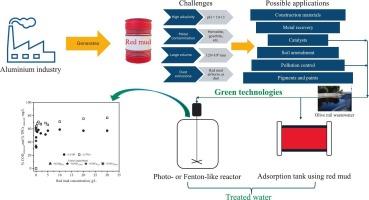Red mud-efficient catalyst for the treatment of real olive mill wastewater through advanced oxidation toward greener and sustainable practices
IF 6.7
2区 工程技术
Q1 ENGINEERING, CHEMICAL
引用次数: 0
Abstract
Recirculation of red mud residue as an efficient catalyst for treating real olive mill wastewater (OMW) via Fenton and photo-Fenton-like processes presents a sustainable approach to addressing environmental challenges in the aluminum industry. To be precise, the large storage areas required for disposal and the likelihood of spills and groundwater contamination should be reduced. Red mud (RM) has a metal composition on a dry weight basis of 82.2 %, with iron compounds (α-Fe3+O(OH) and Fe2O3) having compositions up to 31 %. RM showed a heterogeneous particle size distribution, mainly with particle sizes ranging from 100 to 600 μm. Adsorption, heterogeneous Fenton, and photo-Fenton-like reactions were employed to remove the organic matter, including phenolic compounds in the OMW, demonstrating significant removal efficiencies. The highest removal efficiencies were observed in the oxidation system under the following conditions: RM concentrations above 1 g/L, agitation rate of 460 rpm, pH 3, ambient temperature, and H2O2 concentration at 10 % w/v (131.2 mL/L). Under these conditions, the removal percentages were as follows: TCremoval = 80.9 %, TOCremoval = 75.7 %, ICremoval = 99.8 %, TNremoval = 48.5 %, CODremoval = 58.3 %, and TPCremoval = 70.6 %. The reuse of RM (minimum 6 times) as a catalyst contributes to waste minimization and enhances the sustainability of the aluminum industry by providing a cost-effective and environmentally friendly solution for wastewater treatment.

红泥高效催化剂,通过高级氧化处理真正的橄榄厂废水,朝着更环保和可持续的做法
再利用赤泥渣作为高效催化剂,通过Fenton和光Fenton-like工艺处理真正的橄榄厂废水(OMW),为解决铝工业的环境挑战提供了一种可持续的方法。确切地说,应该减少处置所需的大型储存区域以及减少泄漏和地下水污染的可能性。赤泥(RM)的金属成分在干重基础上占82.2%,其中铁化合物(α-Fe3+O(OH)和Fe2O3)的成分高达31%。RM的粒径分布不均匀,主要分布在100 ~ 600 μm之间。采用吸附、非均相Fenton和光Fenton样反应去除有机物,包括OMW中的酚类化合物,显示出显著的去除效率。在以下条件下,氧化系统的去除率最高:RM浓度大于1 g/L,搅拌速度为460 rpm, pH为3,环境温度为3,H2O2浓度为10% w/v (131.2 mL/L)。在此条件下,去除率分别为:TCremoval = 80.9%, TOCremoval = 75.7%, ICremoval = 99.8%, TNremoval = 48.5%, CODremoval = 58.3%, TPCremoval = 70.6%。RM作为催化剂的重复使用(至少6次)有助于减少废物,并通过为废水处理提供具有成本效益和环保的解决方案,增强铝工业的可持续性。
本文章由计算机程序翻译,如有差异,请以英文原文为准。
求助全文
约1分钟内获得全文
求助全文
来源期刊

Journal of water process engineering
Biochemistry, Genetics and Molecular Biology-Biotechnology
CiteScore
10.70
自引率
8.60%
发文量
846
审稿时长
24 days
期刊介绍:
The Journal of Water Process Engineering aims to publish refereed, high-quality research papers with significant novelty and impact in all areas of the engineering of water and wastewater processing . Papers on advanced and novel treatment processes and technologies are particularly welcome. The Journal considers papers in areas such as nanotechnology and biotechnology applications in water, novel oxidation and separation processes, membrane processes (except those for desalination) , catalytic processes for the removal of water contaminants, sustainable processes, water reuse and recycling, water use and wastewater minimization, integrated/hybrid technology, process modeling of water treatment and novel treatment processes. Submissions on the subject of adsorbents, including standard measurements of adsorption kinetics and equilibrium will only be considered if there is a genuine case for novelty and contribution, for example highly novel, sustainable adsorbents and their use: papers on activated carbon-type materials derived from natural matter, or surfactant-modified clays and related minerals, would not fulfil this criterion. The Journal particularly welcomes contributions involving environmentally, economically and socially sustainable technology for water treatment, including those which are energy-efficient, with minimal or no chemical consumption, and capable of water recycling and reuse that minimizes the direct disposal of wastewater to the aquatic environment. Papers that describe novel ideas for solving issues related to water quality and availability are also welcome, as are those that show the transfer of techniques from other disciplines. The Journal will consider papers dealing with processes for various water matrices including drinking water (except desalination), domestic, urban and industrial wastewaters, in addition to their residues. It is expected that the journal will be of particular relevance to chemical and process engineers working in the field. The Journal welcomes Full Text papers, Short Communications, State-of-the-Art Reviews and Letters to Editors and Case Studies
 求助内容:
求助内容: 应助结果提醒方式:
应助结果提醒方式:


